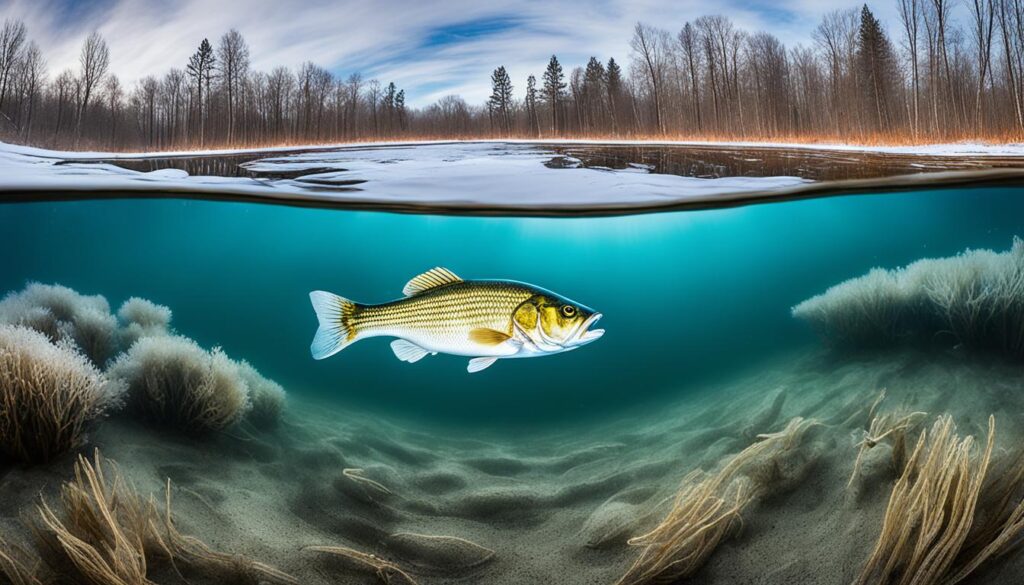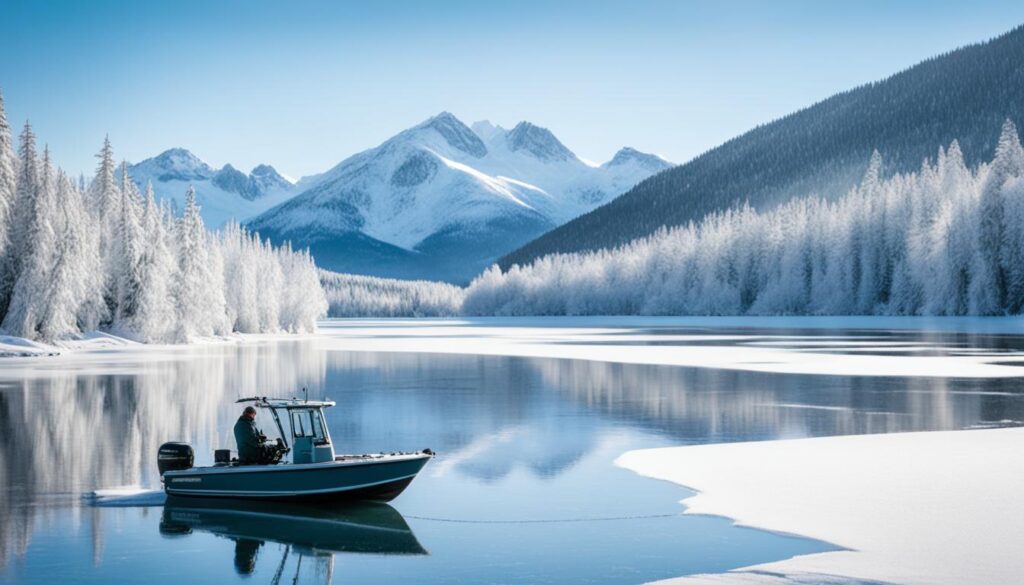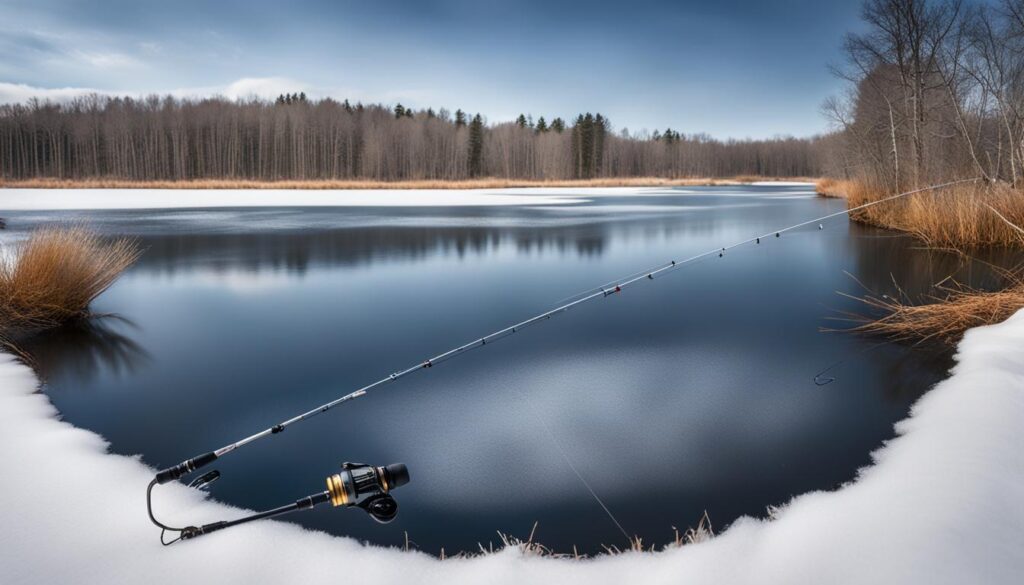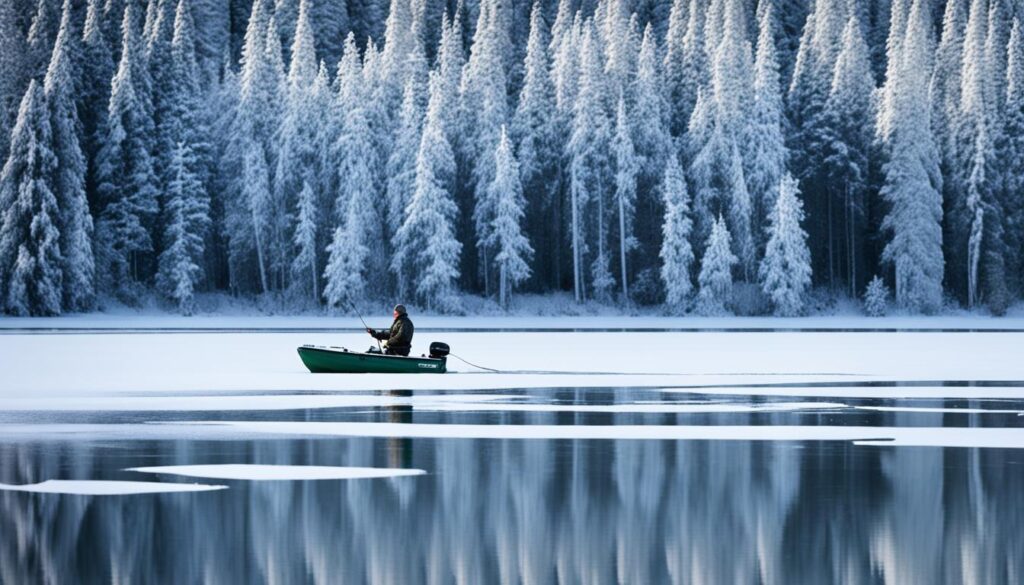Winter bass fishing on new lakes can be an exciting challenge for anglers looking to explore unfamiliar waters and increase their bass-catching skills. In this step-by-step guide, we will provide you with tips and strategies to help you navigate the winter months and find success in your fishing adventures.
When it comes to winter bass fishing, new lakes offer a fresh and exciting opportunity to test your angling abilities. However, the unfamiliarity of these waters can make the task seem daunting. With our comprehensive guide, you will learn how to make the most of your time on new lakes during the winter season.
Key Takeaways:
- Winter bass fishing on new lakes can be challenging but rewarding
- Having the right equipment and tackle is crucial for success
- Utilize technologies like side imaging and mapping tools to locate bass
- Positioning your boat strategically can improve your chances of catching fish
- Start with a moving bait and switch to finesse techniques as needed
Equipment and Tackle Recommendations
To effectively search for bass on new lakes in winter, it is important to have the right equipment and tackle. Here are our recommendations:
Fish Finders
Having a reliable fish finder can greatly enhance your fishing experience. We suggest the following fish finders:
| Fish Finder | Description |
|---|---|
| Humminbird HELIX 12 MEGA SI+ G4N | A top-of-the-line fish finder with side imaging for a comprehensive view of the lake. |
| Humminbird MEGA 360 Imaging | Provides a detailed 360-degree view of the underwater structure, allowing you to pinpoint bass-holding areas. |
With these fish finders, you’ll have a clear picture of what’s below the surface and be able to locate bass more effectively.
Boat Equipment
Equipping your boat with the right tools will make your fishing excursion more productive. Consider the following boat equipment:
- Trolling Motor: A quality trolling motor like the Minn Kota Ultrex will help you navigate and stay in productive fishing spots.
- Shallow Water Anchors: Minn Kota Raptors are excellent shallow water anchors that will keep your boat steady, even in windy conditions.
Tackle Recommendations
Choosing the right tackle is crucial for enticing bass in winter. We recommend the following tackle:
| Tackle | Description |
|---|---|
| Crankbait | The Rapala DT 8 crankbait is ideal for locating bass in different depths and imitating baitfish. |
| Finesse Setup | For catching additional fish, use a finesse setup with a VMC Tokyo Rig and Z-Man Big TRD. This combination will entice bass that are not actively feeding. |
Scanning with Side Imaging
Utilizing side imaging sonar is crucial for mapping out new lakes, especially those that may not have detailed contours. Side imaging allows you to see the bottom composition, including rocks, wood, and weeds, as well as any transitions between different types of bottom. By scanning the lake with side imaging, you can locate offshore structure, such as rock piles, which are often productive areas for bass.

Side imaging sonar is a powerful tool for anglers looking to explore unfamiliar waters. It provides a detailed view of the lake’s underwater landscape, helping you identify potential hotspots and fishing areas. The image above showcases the clarity and level of detail that can be obtained with side imaging.
| Benefits of Side Imaging | How to Use Side Imaging effectively |
|---|---|
|
|
Side imaging technology has revolutionized the way anglers approach lake fishing. Its ability to provide a detailed view of underwater structures and features makes it an invaluable tool for mapping out new lakes and locating offshore structure. By utilizing side imaging effectively, you can increase your chances of finding productive areas and targeting bass with precision.
Dropping Waypoints on Key Edges
Once you have identified productive areas using side imaging, it is important to drop waypoints on key edges. These edges can be the contours of the structure you wish to fish, such as the crown of a rock pile or the ends of a particular feature. By dropping waypoints, you create casting targets and increase your chances of accurately fishing the structure. This technique allows you to stay off the spot and make long, precise casts to where you expect the fish to be.
Key Edges Waypoint Chart
| Waypoint Number | Location | Structure Type |
|---|---|---|
| 1 | Rock Pile Crown | Rock |
| 2 | End of Point | Submerged Vegetation |
| 3 | Dip in Creek Channel | Underwater Structure |
| 4 | Stump Line | Wood |
By carefully dropping waypoints on key edges, you can effectively navigate the fishing structure and improve your chances of landing bass. Refer to the waypoint chart above to plan your fishing strategy based on specific structure types and locations.
Positioning the Boat for Success
When it comes to maximizing your fishing success on new lakes, proper positioning of your boat is key. By utilizing waypoint sharing and strategic boat placement, you can optimize your fishing strategies and improve your chances of reeling in that trophy bass.
Waypoint sharing is an invaluable capability that allows you to sync your console and bow electronics, enabling you to utilize your reconnaissance efforts effectively. By referencing your waypoints on the bow, you can keep your boat off the productive fishing spots and avoid spooking the bass.
Positioning your boat off the edge of the structure or in an area that will not disturb the fish is crucial. By doing so, you create a stealthy presence that won’t alert the bass to your presence. This technique involves placing your boat strategically to maintain a safe distance from the fish while still allowing you to make accurate casts and presentations.
Seth Feider, a renowned professional angler, suggests positioning your boat off the edge of a rock formation. By employing 360 Imaging and combining it with a detailed structure readout, he can visualize his waypoints precisely, guiding him to potential hotspots and increasing his chances of success.
The Importance of Waypoint Sharing
Waypoint sharing plays a crucial role in your fishing strategy. It allows you to utilize your boat’s electronics to their full potential, keeping you on track and positioning your boat strategically. By sharing waypoints between your console and bow electronics, you can have a clear picture of the productive areas without compromising your position.
Strategic Boat Placement
Strategic boat placement is vital for successful fishing. By positioning your boat off the edges of key structures or in non-disruptive areas, you maintain a low profile and increase your chances of enticing bass to bite. Staying off the structure and casting towards it helps you avoid spooking the fish and allows for accurate presentations.
| Advantages of Strategic Boat Placement | Benefits |
|---|---|
| Minimizes Disturbances | Keeps the boat from spooking the fish and disrupting their natural behavior. |
| Accurate Presentations | Allows for precise casts and presentations to the structure and potential hotspots. |
| Increases Hookup Rates | Positions you within optimal range for successful hook sets and landing bass. |
By implementing these waypoint sharing and strategic positioning techniques, you can enhance your fishing experience on new lakes. Remember to keep your boat off the productive fishing spots, utilize your electronics to their full potential, and maintain a stealthy presence to maximize your chances of a successful catch.

Using a Moving Bait First
When you’re ready to start fishing in a new lake, it’s a good idea to begin with a moving bait. Among the various options, a crankbait like the Rapala DT 8 is highly recommended for triggering bass bites, especially around rocks that attract crawfish and bluegills. The realistic action and vibration of a crankbait can entice the bass to strike.
By using a moving bait, such as a crankbait, you can cover more water quickly, increasing your chances of finding active fish and eliminating unproductive areas. This technique allows you to efficiently search different parts of the lake and locate potential bass hotspots.
When you hook your first fish, make repeated casts to the same spot, as there’s often a group of bass in the area. Additionally, fan your casts out to expand your search without needing to move your boat. This approach helps you explore a wider range of water and increases the probability of encountering more bass.

| Moving Bait Tips | Benefits |
|---|---|
| Start with a crankbait like the Rapala DT 8 | – Triggers bass bites – Effective around rocks with crawfish and bluegills |
| Cover more water quickly | – Maximizes chances of finding active fish – Efficiently eliminates unproductive areas |
| Repeat casts to the same spot | – Targets groups of bass in the area |
| Fan out casts to expand your search without moving the boat | – Explores more water without disturbing fish |
Switching to a Finesse Bait
If the moving bait fails to produce additional bites, it’s time to switch to a finesse bait. This finesse fishing technique involves using a finesse bait, such as the Z-Man Big TRD rigged on a VMC Tokyo Rig Finesse Neko, to entice bass that are not willing to chase or are conditioned to heavier baits.
Seth Feider, a renowned bass angler, recommends casting the finesse bait back to the same spots where the crankbait produced bites. To maximize success, employ a bottom presentation, allowing the finesse bait to mimic natural forage near the lake bottom. This finesse technique has proven effective in enticing additional bites, often resulting in several more fish, including larger ones.
By switching to a finesse bait, you have the opportunity to target bass that may have been less responsive to a moving bait. The finesse presentation and bottom presentation technique can be especially effective in colder water temperatures when bass are more lethargic and less likely to aggressively chase fast-moving baits.
Understanding Seasonal Patterns
Understanding seasonal patterns is crucial for successful bass fishing. Different seasons bring changes in water temperature, which in turn affects the behavior and movement of bass. By understanding these patterns, you can adapt your fishing strategies and increase your chances of a successful catch.
Winter Fishing
In winter, bass become more lethargic and tend to move to deeper water to find stable water temperatures. The cold water slows down their metabolism, and they become less active. To locate winter bass, look for areas with rock or other structure that can hold heat. These spots act as thermal refuges and attract bass, providing them with slightly warmer water compared to the surrounding areas.
Spring Fishing
As the water temperature warms up in spring, bass become more active. They start feeding more aggressively and may move to shallower waters. During the spring spawning period, bass may migrate to spawning flats and target spawning baitfish. Look for areas with vegetation, such as emergent grass or lily pads, as these can provide cover and serve as ideal spawning grounds for bass.
Summer Fishing
Summer fishing requires finding deeper structure and understanding thermoclines. As the water temperature rises, bass tend to move to deeper water where the temperature is more stable. Look for drop-offs, humps, or submerged vegetation in deeper areas of the lake. Understanding thermoclines can also be beneficial as bass may position themselves at specific depths where the temperature and oxygen levels are optimal.
Fall Fishing
Fall bass fishing focuses on feeding periods as the water cools down and bass prepare for the winter months. During this time, bass can be found in shallower areas, targeting baitfish that are abundant as they migrate to warmer water. Look for areas with cover, such as fallen trees or submerged vegetation, where bass can ambush their prey. Focus on areas where baitfish are present, as bass will often be nearby.
By understanding these seasonal patterns, you can adjust your fishing techniques and target the areas where bass are most likely to be. Remember to monitor water temperature and adapt your strategies accordingly. Each season brings its own challenges and opportunities, so stay flexible and open to experimenting with different techniques to maximize your chances of success.
Utilizing Google Earth for Pre-Trip Scouting
Google Earth is a valuable tool for scouting new lakes before your trip. By using the satellite imagery feature, you can view the lake from a bird’s eye perspective and identify potential fishing spots. Look for rock piles, creek channels, points, and other underwater structures that remain consistent over time.
“Google Earth allows me to get a sense of the entire lake and identify areas that I want to explore further. It’s like having an aerial tour of the lake without leaving my home.” – Experienced Angler
You can also drop waypoints on these spots and save them for future reference. This will help you create a game plan and save time when you arrive at the lake.
| Benefits of Google Earth for Pre-Trip Scouting | How to Use Google Earth for Scouting |
|---|---|
|
|
By leveraging the power of Google Earth, you can gain valuable insights into the layout of new lakes and pinpoint areas that are likely to hold bass. Use this tool to your advantage and enhance your pre-trip scouting process for a more successful fishing adventure.
Refining Your Search with Lake Maps
In addition to utilizing Google Earth, lake maps can be a valuable tool for refining your search for bass. Whether you prefer using smartphone apps like Navionics or physical maps, these resources provide valuable information about the underwater structure of the lake. By gaining insights into the contours, depth changes, and potential hiding spots, you can identify prime fishing areas. Cross-referencing multiple maps can further enhance your understanding of the lake’s layout and help you locate areas with potential cover and structure.
Having access to detailed lake maps improves your fishing efficiency on the water. By narrowing down the search and focusing on specific areas, you can spend more time casting and less time searching aimlessly. The knowledge gained from lake maps allows you to make better-informed decisions, increasing your chances of finding fish.
Benefits of Lake Maps:
- Understanding the underwater topography and structure
- Identifying potential cover and hiding spots for bass
- Narrowing down the search area for more efficient fishing
- Increasing the chances of locating fish by focusing on prime spots
“Lake maps provide invaluable insights into the underwater world, helping anglers identify key locations and make informed decisions. By utilizing these resources, you can enhance your fishing efficiency and improve your chances of a successful day on the water.”
Combining the knowledge gained from lake maps with other techniques, such as scanning with side imaging and dropping waypoints, further enhances your ability to locate and catch bass. By utilizing a comprehensive approach, you can maximize your fishing potential and make the most of your time on new lakes.
Fishing Tips from the Pros
When it comes to targeting bass in different conditions, fishing guides Randy Pringle and Rich Tauber have a wealth of knowledge to share. These pro tips will help you improve your bass fishing tactics and increase your chances of success on the water.
Randy Pringle’s Top Tips for Low-Light Conditions
“The early morning and evening hours are prime time for bass fishing during low-light conditions. Take advantage of this opportunity by using topwater lures that create enticing surface action. Bass are more likely to strike at these times, and topwater baits like poppers, walking baits, and buzzbaits can be incredibly effective.”
Rich Tauber’s Advice on Targeting Bass in Cover
“When bass seek cover, it’s important to focus your efforts in these areas. Look for grass, moss, or other forms of cover in the water, as bass often hide and feed in these spots. To entice bass in cover, I recommend using Texas-rigged worms or drop-shot rigs. These techniques allow you to present your bait effectively and entice strikes from bass that are holding tight to cover.”
Both Randy Pringle and Rich Tauber emphasize the importance of understanding bass behavior and adapting your fishing tactics accordingly. By following their expert advice, you can significantly improve your chances of landing more bass and having a successful fishing trip.
Conclusion
Winter bass fishing on new lakes can present both challenges and rewards. By following the step-by-step guide and implementing the recommended techniques, equipment, and tackle, you can significantly increase your chances of success. Understanding seasonal patterns, leveraging technology such as Google Earth and lake maps, and adapting your fishing tactics based on expert advice will help you locate and catch bass in unfamiliar waters.
It is essential to conduct thorough research and plan ahead before your trip. Familiarize yourself with the target lake, its topography, and any available satellite imagery. By doing so, you can create a game plan and save valuable time once you are on the water. However, remain open to adjusting your strategy based on the prevailing conditions and the behavior of the bass you encounter.
Remember, winter bass fishing can be a captivating experience, filled with excitement and possibilities. Armed with the knowledge and techniques acquired through this guide, you are well-equipped to embark on your fishing adventures. So, get out there and make the most of this incredible winter bass fishing season. Tight lines!
FAQ
What equipment and tackle do I need for winter bass fishing on new lakes?
Recommended equipment includes fish finders like the Humminbird HELIX 12 MEGA SI+ G4N and the Humminbird MEGA 360 Imaging. Boat equipment such as the Minn Kota Ultrex trolling motor and Minn Kota Raptors shallow water anchors are also helpful. For tackle, consider using a crankbait like the Rapala DT 8 and a finesse setup with a VMC Tokyo Rig and Z-Man Big TRD.
How can I map out new lakes using side imaging?
Side imaging sonar is crucial for mapping out unfamiliar lakes. It allows you to see the bottom composition and locate offshore structure like rock piles. By using side imaging, you can identify productive areas and drop waypoints on key edges for accurate fishing.
What is the best way to position my boat for success?
Waypoint sharing is a valuable capability that allows you to keep your boat off productive fishing spots. Position your boat off the edge of the structure or in an area that will not disturb the fish. This strategy helps you avoid spooking the bass and increases your chances of catching them.
Should I start with a moving bait or finesse bait?
It is recommended to start with a moving bait like a crankbait to cover water quickly and locate bass. If the moving bait fails to produce bites, switch to a finesse presentation with a finesse bait like the Z-Man Big TRD on a VMC Tokyo Rig. This can entice bass that are not willing to chase or are conditioned to heavier baits.
What seasonal patterns should I consider for winter bass fishing?
In winter, bass become more lethargic and tend to move to deeper water to find stable water temperatures. Look for areas with rock or other structure that can hold heat and attract bass. In spring, bass become more active as the water temperature warms up. Summer fishing requires finding deeper structure and understanding thermoclines. Fall bass fishing focuses on feeding periods as the water cools down, and bass move to shallower areas.
How can I utilize Google Earth for scouting new lakes?
Google Earth is a valuable tool for scouting new lakes. By using the satellite imagery feature, you can view the lake from a bird’s eye perspective and identify potential fishing spots. Look for rock piles, creek channels, points, and other underwater structures that remain consistent over time. You can also drop waypoints on these spots and save them for future reference.
How can lake maps help refine my search for bass?
Lake maps, whether in the form of apps like Navionics or physical maps, provide valuable information about underwater structure. By cross-referencing multiple maps, you can gain a better understanding of the lake’s layout and locate areas with potential cover and structure. This knowledge will improve your on-the-water efficiency and increase your chances of finding fish.
What fishing tips can I learn from the pros?
Fishing guides like Randy Pringle and Rich Tauber provide expert tips for targeting bass in different conditions. Pringle emphasizes fishing during low-light conditions and using topwater lures in the morning and evening. Tauber suggests focusing on areas with cover, such as grass or moss, and using Texas-rigged worms or drop-shot rigs. Both guides emphasize the importance of understanding bass behavior and adapting your fishing tactics accordingly.
What is the step-by-step guide for winter bass fishing on new lakes?
The step-by-step guide includes equipping yourself with the right equipment and tackle, scanning the lake with side imaging, dropping waypoints on key edges, positioning your boat for success, starting with a moving bait, switching to a finesse bait if necessary, understanding seasonal patterns, utilizing Google Earth for pre-trip scouting, refining your search with lake maps, and learning fishing tips from the pros. By following this guide, you can increase your chances of success.
